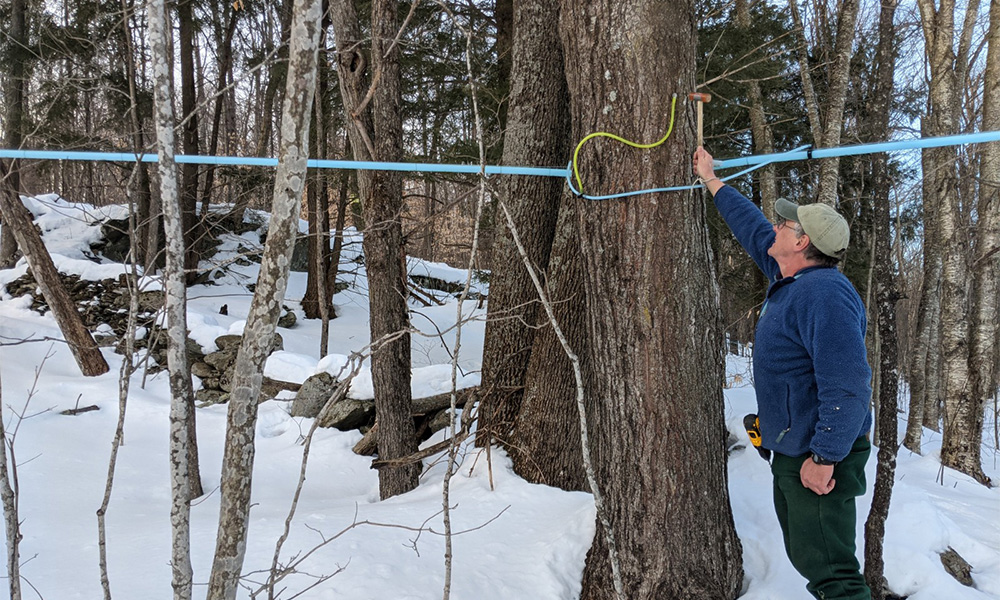Views of U.S. and Canadian Maple Syrup Producers on Climate Change
Mar. 1st 2021The sweet taste of pancakes dripping with maple syrup, sugar-on-snow, and other maple treats. Sugar bushes, filled with tall maple trees, covered in snow. These are the visions conjured by thoughts of maple syrup, the delicious gift from trees that defines many forests of the northeastern United States and southeastern Canada.
Producing maple syrup is a delicate and arduous process, and it is one that requires a very in-tune relationship of sugarmaker with the sugar bush. Annually, a tree’s sap can vary in its quantity and sugar content; it depends on how the sap is harvested and seasonal weather.
Temperature is the most important factor in determining the amount of sap available from a maple tree. Conditions conducive to the greatest amount of sap involve freezing nights and a slight thawing during the day. During this cycle, the roots of maple trees can begin taking up water from the soil. This is followed by negative and positive pressures in the trunk and branches of the tree, which facilitate sap exudation or dripping from tap holes.
The traditional sap season lasts for about four to six weeks in late winter and early spring. The season’s close is brought on by warm temperatures persisting for several days straight (greater than 10° C or 50° F). The season generally runs from February through April, but a changing climate is beginning to alter that timeframe, with some producers now sugaring as early as January. However, not all sugarmakers are equally prepared to encounter a changing climate.
To determine how the perceptions of U.S. and Canadian maple syrup producers are affected by climate change and how these perceptions may impact the industry, a team of researchers conducted a study by issuing an online survey to 354 sugarmakers throughout Quebec and Ontario and the northeastern and midwestern United States. Important to note, Quebec produces roughly 70% of the global supply of maple syrup, and Vermont is the largest producer in the United States.
The survey was comprised of three sections–one covering opinions towards climate change in general, the next about climate change’s impact on maple syrup production, and the last about adapting production methods to respond to climate change. In addition to measuring attitudes, respondents’ demographic and socio-economic data were gathered, including political view and education level. The survey also collected information about the sugar bush operation including tap methods and technologies used.
Researchers hypothesized that because sugaring operations are intricately linked to climate, maple syrup producers would be sensitive to the scientific consensus concerning climate change, regardless of political stance. However, the results contradicted this hypothesis. In fact, according to Daniel Houle, Associate Professor at the Université du Québec à Montréal, “political view is the most important factor determining the responses for the perceived impacts of climate change.”
Ninety percent of respondents who identify politically as left of center are fairly to very confident that the average temperature on Earth is increasing, compared to 75% of respondents as a whole. As for the cause of climate change, 65% of those who are left of center identify human activity as the driving cause, whereas only 20% of respondents as a whole state the same. Respondents who are right of center are more likely to agree that climate change impacts are happening slowly enough for them to adapt and that the impacts are exaggerated. Furthermore, respondents right of center are less likely to believe that changes in the timing of the tapping season will continue.
Maple syrup production is intricately linked to climate. However, because regional climates vary, changing syrup yield and flow time due to climate change may be felt differently in different places. The climatic envelope most conducive to sugaring is pushing northward, which poses the most imminent threat to the southernmost parts of the U.S. states involved in the sugaring process.
The southernmost portion of U.S. sugar producers did report the greatest negative impact in tap yields from recent decades, demonstrating what may be the already occurring climatic shifts in maple sugar production. However, the personal experience of these producers does not shape their opinions of climate change and the future of the industry as much as political view does. As Dr. Houle stated, “political view appears to be a stronger predictor of producers’ beliefs about future climate change impacts than personal experience due to past exposure to climate change effects.”
As for adaptation measures, those who are already using newer technologies such as vacuum tubing are more likely to agree that new ways are needed in the industry to adapt to climate change. Unfortunately, this may mean that those who are more open to change are already doing so, and those who are reluctant to change may have a harder time with adaptation. In this area, lack of financial means is seen as the greatest barrier to adopting new technologies that may help with future changes in maple forests and sugaring.
A quarter of those surveyed say that their disbelief that climate change will impact sugaring prevents them from adopting adaptation measures. The researchers state that future disruptions in the climate may force this group of sugarmakers to change their beliefs.
 ecoNEWS VT
ecoNEWS VT